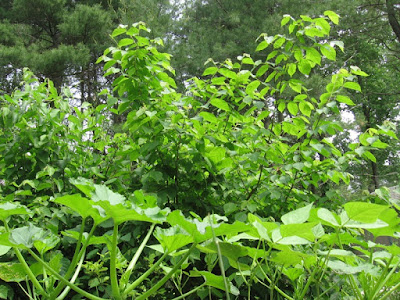
"Fiddleheads": Ostrich ferns, often grown in shade gardens as an ornamental, have edible young shoots that are an early spring delicacy.
Early spring offers an abundance of what I like to call "free food." Perennial vegetables, many of them native species of forest and field, are often the first plants to emerge in spring, coming back year after year with little work on our part other than to tend to ensuring a healthy ecosystem around them.
In general, perennials require much less work than the annual food plants American and European agriculture has focused on developing. With their well-established root systems, they don't need to be carefully watered, weeded, and protected from insects, unlike small annual seedlings just trying to get themselves established on open, bare ground. Many are woodland or meadow species, growing early, before other plants leaf out. They do, however, require that we nurture an ecosystem that fosters what appears to be a natural tendency toward abundance.

Wild onions are ready to harvest in early April
Unfortunately, the clear-cutting of native forests through the early 19th century means many of these perennial edibles are less widespread than they used to be. So we've been reintroducing them into our gardens and woods. The wild onions came from Richard's parents' land, the Solomon Seal from his mother's gardens, and the Ostrich fern from last year's Cooperative Extension plant sale (gardener unknown). I think I acquired the first of the Good King Henry (perennial spinach) plants from one of the vendors at the Ithaca's farmers market.
I am delighted that both the wild onions and Ostrich ferns -- both planted in the moist soil near the stream -- have begun to naturalize and spread. We've been digging small quantities of the former for the past two years, while waiting for the latter -- the source of delectable (and expensive) "fiddlehead" ferns found in gourmet groceries and upscale restaurants -- to create a more sizable colony. In the meantime, we tasted a few fiddleheads from my friend Alicia's gardens. Sauteed in some sesame oil, they were wonderful.
The Good King Henry, which like other wild spring edibles tolerates shade, is planted in the front gardens. I rarely get around to cutting off seed heads, so our crop has grown as it has seeded itself. Unlike domesticated spinach, Good King Henry requires little tending and continues to produce sizable leaves throughout the summer heat. While older leaves need to be briefly cooked (to remove the oxalic acid common to this family of plants), it freezes well and serves as a wonderful spinach substitute for winter soups and stews.

Good King Henry, a perennial spinach,
produces edible leaves through the summer heat
Solomon Seal, a common "ornamental" in many shade gardens, can be harvested as young shoots (before the leaves open) and cooked and eaten like asparagus. While it will never replace the tender, delicate taste of asparagus, it also doesn't need the fertilizing, mulching, watering, and general tending that asparagus requires. So we have and tend our asparagus patch, but we also appreciate the early Solomon Seal shoots.

Solomon Seal shoots can be cooked like asparagus

Asparagus shoots: one of the few "fussy" perennials
Of course, there are also the perennial salad and cooking "greens" that I have already been writing about: sorrel, Sweet Cicely, and the mints.
The ramps (wild leeks) are a new addition this year. Richard's dad dug them for us from his brother Dick's land, and Richard planted them in various locations throughout the woods. An early spring delicacy, the slow-to-mature wild leeks are also an indicator species, signaling the health of the surrounding forest. So we'll watch and hope they establish themselves, and do our part to dig them judiciously and help them spread.

Ramps (wild leeks) are a wonderful addition to early spring omelets.















